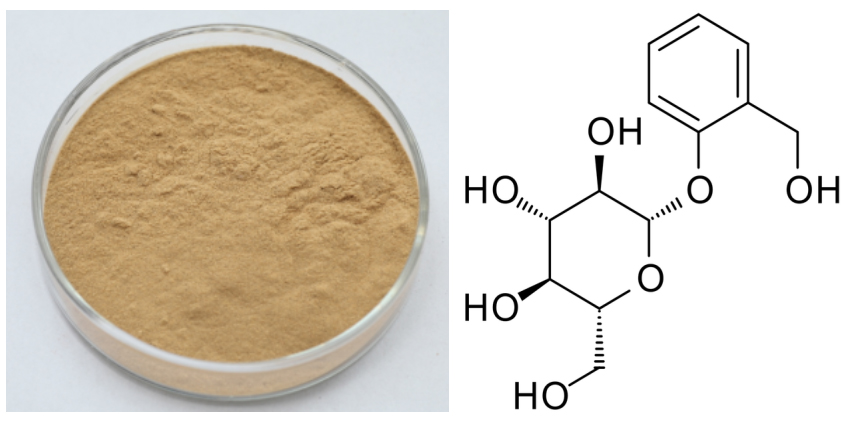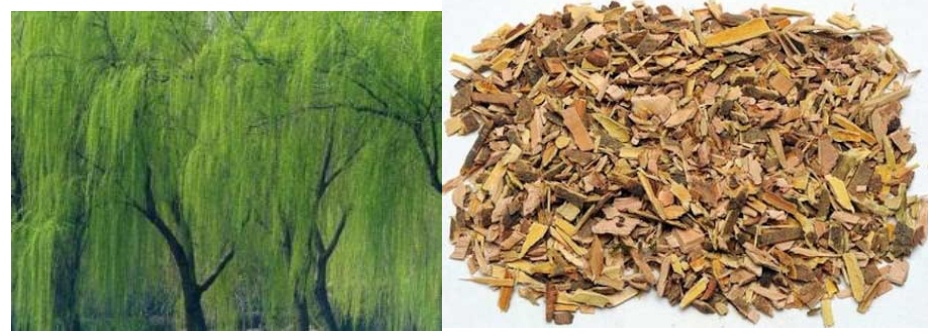High Quality White Willow Bark Extract Factory for Guatemala
High Quality White Willow Bark Extract Factory for Guatemala Detail:
[Latin Name] Salix alba L.
[Plant Source] from China
[Specifications] Salicin 15-98%
[Appearance] Yellow Brown to White powder
Plant Part Used: Bark
[Particle size] 80 Mesh
[Loss on drying] ≤5.0%
[Heavy Metal] ≤10PPM
[Storage] Store in cool & dry area, keep away from the direct light and heat.
[Shelf life] 24 Months
[Package] Packed in paper-drums and two plastic-bags inside.
[Net weight] 25kgs/drum
Brief Introduction
Salicin is a naturally occurring compound found in the bark of several species of trees, primarily North American in origin, that are from the willow, poplar, and aspen families. White willow, from whose Latin name, Salix alba, the term salicin is derived, is the most well known source of this compound, but it is found in a number of other trees, shrubs, and herbaceous plants as well being synthesized commercially. It is a member of the glucoside family of chemicals and is used as an analgesic and antipyretic. Salicin is used as a precursor for the synthesis of salicylic acid and acetylsalicylic acid, commonly known as aspirin.
A colorless, crystalline solid in its pure form, salicin has the chemical formula C13H18O7. Part of its chemical structure is equivalent to the sugar glucose, meaning it is classified as a glucoside. It is soluble, but not strongly so, in water and alcolhol. Salicin has a bitter taste and is a natural analgesic and antipyretic, or fever reducer. In large quantities, it can be toxic, and overdoses may lead to liver and kidney damage. In its raw form, it may be mildly irritating to skin, respiratory organs, and eyes.
Function
1. Salicin is used to ease pain and reduce inflammation.
2. Relieve acute and chronic pain, including headache, back and neck pain, muscle aches, and menstrual cramps; Control arthritis discomforts.
3. Relieve acute and chronic pain.
4. It has the same effect on the body as aspirin without any of the side effects.
5. It is an anti-inflammatory, a fever reducer, an analgesic, an anti-rheumatic, and an astringent. Specifically, it helps to relieve headaches.
Application
1.Anti-inflammatory, anti-rheumatic,
2.Reduce a fever,
3.Use as an analgesic and astringent,
4.Relieve headache,
5.Ease pain caused by rheumatism, arthritis, and carpal tunnel syndrome.
Product detail pictures:

Related Product Guide:
Our enterprise since its inception, usually regards product top quality as business life, repeatedly enhance manufacturing technology, make improvements to product excellent and continuously strengthen enterprise total high quality administration, in strict accordance with all the national standard ISO 9001:2000 for High Quality White Willow Bark Extract Factory for Guatemala , The product will supply to all over the world, such as: Tunisia, Victoria, Mauritius, Our company abides by the management idea of "keep innovation, pursue excellence". On the basis of assuring the advantages of existing merchandise, we continuously strengthen and extend product development. Our company insists on innovation to promote the sustainable development of enterprise, and make us become the domestic high-quality suppliers.
I do use Stevia. I have a really sweet tooth, and have been on the lookout for a solution that helps managing my sugar intake, as I do think sugar is just as addictive and just as harmful as alcohol. I rarely drink and don’t have cravings for a “nice glass of wine”; but when it comes to sweet taste I’m losing all my self-control…
Stevia is a natural sweetener. Although in the last couple of years it has been becoming a mainstream ingredient in the European and US market too, for many it is still an unknown option when it comes to substituting sugar or artificial sweeteners.
What is Stevia?
Stevia is a plant with green leaves growing 2-4 feet tall. It is a native plant to South America; Paraguayan tribes have been using it for centuries as a sweetener and as a medicine too.
Stevia is an herb. Its Latin name is Stevia Rebaudiana Bertoni. It belongs to the Composite family that includes for example lettuce and chicory. The two main compounds that are responsible for Stevia’s sweet taste are called Stevioside and Rebaudioside A that found in the plant’s leaves.
There are many different types of Stevia. The quality of the sweet flavour of Stevia depends on the species used in production and what form it is consumed in. You can find Stevia in powder and liquid forms. The most natural form that it can be consumed in is the green powder. It is made by simply grounding the dried Stevia leaves. It is about 10-15 times sweeter than sugar. The white powder form is a processed form of Stevia. Its consistence is very similar to caster sugar, but it is several times more concentrated (varies depending on brands). The liquid extract commonly contains alcohol, but alcohol free products can be purchased from different suppliers too. The processed forms (powder or liquid) can be 100-300 times sweeter than sugar.
https://www.anti-aging-now.com/grapeseed-extract.html -Grape seeds have a high concentration of flavonoids and oligomeric proanthocyanidins, (OPC). These compounds also found in grape seed in lower concentrations in grape skin, and . Grape seed contains various lipids, including the omega-6 fatty acid linoleic acid and the omega-9 fatty acid oleic acid. Grape seed provides the essential amino acids leucine, phenylalanine and valine, and the non-essential amino acids arginine and cystine.
OPCs are found in grape juice and wine. OPC is why we have what is called the French Paradox in that people in France who drink a lot of red wine don’t tend to have a lot of heart problems. Even though they smoke and eat a lot of fatty foods.
The after-sale warranty service is timely and thoughtful, encounter problems can be resolved very quickly, we feel reliable and secure.







